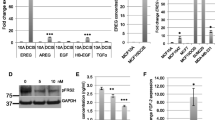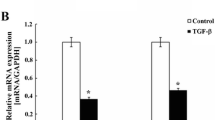Abstract
Breast cancer, the most common malignancy among women worldwide, is a heterogeneous disease, and it therefore has remarkably different biological characteristics and clinical behavior. Breast cancer has been divided into several different molecular subtypes based on the status of estrogen receptor (ER), progesterone receptor (PR), human epidermal growth factor 2 (HER2, also named as ErbB2) status. Her2 is a member of EGFR family of transmembrane tyrosine kinase-type receptors, and is involved in the activation of its downstream signaling cascades, which could promote cell proliferation, metastasis, and angiogenesis in tumors. In addition, Twist, a transcriptional factor has been shown to associate with ErbB2 signaling to increase the proliferation and the number of cells, and to induce epithelial–mesenchymal transition. Deregulated cell proliferation can result in hyperplasia and even malignancies. Actually, the proliferative or survival ability of cells can be measured by a variety of methods. Clonogenic assay and CCK8 assay can serve as useful tools to test whether the clonogenic survival ability of tumor cells can be enhanced or reduced upon stimulation of appropriate mitogenic signals or a given cancer therapy respectively. A colony is defined as a cluster of at least 50 cells that can often only be determined microscopically. Moreover, migration and invasion assay, in some degree, represents the potential for EMT promotion. Here, we introduce colony formation assay; CCK8 proliferation assay; soft agar; and migration and invasion assay using overexpression of ErbB2 and EGFR receptors as an example.
Access this chapter
Tax calculation will be finalised at checkout
Purchases are for personal use only
Similar content being viewed by others
References
Yarden Y, Sliwkowski MX (2001) Untangling the ErbB signalling network. Nat Rev Mol Cell Biol 2(2):127–137
Mendelsohn J, Baselga J (2003) Status of epidermal growth factor receptor antagonists in the biology and treatment of cancer. J Clin Oncol 21(14):2787–2799
Olayioye MA et al (2000) The ErbB signaling network: receptor heterodimerization in development and cancer. EMBO J 19(13):3159–3167
Epis MR et al (2009) miR-331-3p regulates ERBB-2 expression and androgen receptor signaling in prostate cancer. J Biol Chem 284(37):24696–24704
Holbro T, Hynes NE (2004) ErbB receptors: directing key signaling networks throughout life. Annu Rev Pharmacol Toxicol 44:195–217
Hynes NE, Lane HA (2005) ERBB receptors and cancer: the complexity of targeted inhibitors. Nat Rev Cancer 5(5):341–354
Slamon DJ et al (1987) Human breast cancer: correlation of relapse and survival with amplification of the HER-2/neu oncogene. Science 235(4785):177–182
Berger MS et al (1988) Correlation of c-erbB-2 gene amplification and protein expression in human breast carcinoma with nodal status and nuclear grading. Cancer Res 48(5):1238–1243
Di Fiore PP et al (1987) Overexpression of the human EGF receptor confers an EGF-dependent transformed phenotype to NIH 3T3 cells. Cell 51(6):1063–1070
Di Fiore PP et al (1987) erbB-2 is a potent oncogene when overexpressed in NIH/3T3 cells. Science 237(4811):178–182
Hudziak RM, Schlessinger J, Ullrich A (1987) Increased expression of the putative growth factor receptor p185HER2 causes transformation and tumorigenesis of NIH 3T3 cells. Proc Natl Acad Sci U S A 84(20):7159–7163
Benz CC et al (1992) Estrogen-dependent, tamoxifen-resistant tumorigenic growth of MCF-7 cells transfected with HER2/neu. Breast Cancer Res Treat 24(2):85–95
Chazin VR et al (1992) Transformation mediated by the human HER-2 gene independent of the epidermal growth factor receptor. Oncogene 7(9):1859–1866
Teng Y, Li X (2014) The roles of HLH transcription factors in epithelial mesenchymal transition and multiple molecular mechanisms. Clin Exp Metastasis 31(3):367–377
Soini Y et al (2011) Transcription factors zeb1, twist and snai1 in breast carcinoma. BMC Cancer 11:73
Martin TA et al (2005) Expression of the transcription factors snail, slug, and twist and their clinical significance in human breast cancer. Ann Surg Oncol 12(6):488–496
Mironchik Y et al (2005) Twist overexpression induces in vivo angiogenesis and correlates with chromosomal instability in breast cancer. Cancer Res 65(23):10801–10809
Yang J, Weinberg RA (2008) Epithelial-mesenchymal transition: at the crossroads of development and tumor metastasis. Dev Cell 14(6):818–829
Thiery JP et al (2009) Epithelial-mesenchymal transitions in development and disease. Cell 139(5):871–890
Li QQ et al (2009) Twist1-mediated adriamycin-induced epithelial-mesenchymal transition relates to multidrug resistance and invasive potential in breast cancer cells. Clin Cancer Res 15(8):2657–2665
Author information
Authors and Affiliations
Corresponding author
Editor information
Editors and Affiliations
Rights and permissions
Copyright information
© 2017 Springer Science+Business Media LLC
About this protocol
Cite this protocol
Bai, JW., Zhang, YQ., Li, YC., Zhang, GJ. (2017). Analysis of Epithelial–Mesenchymal Transition Induced by Overexpression of Twist. In: Wang, Z. (eds) ErbB Receptor Signaling. Methods in Molecular Biology, vol 1652. Humana Press, New York, NY. https://doi.org/10.1007/978-1-4939-7219-7_17
Download citation
DOI: https://doi.org/10.1007/978-1-4939-7219-7_17
Published:
Publisher Name: Humana Press, New York, NY
Print ISBN: 978-1-4939-7218-0
Online ISBN: 978-1-4939-7219-7
eBook Packages: Springer Protocols




